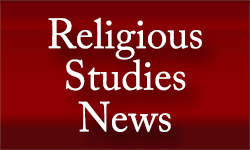|
RSN May 2014Contents
Annual Meeting News
|
Teaching Asian Religions from within the Asian American CommunityEmily S. Wu, Dominican University of California
Asian Religions and Social JusticeOur eighty-seven-year-old Elder, a third-generation descendent of a Chinese American fishing village in northern California, gives us a timid smile from behind the bar of the small diner that he and his family have operated since the 1940s. My students and I have just set up a laptop and microphone to record a first-person account of his life story. The Elder looks over our shoulders to where a man stands with a stern face and his arms crossed—this is a member of the nonprofit organization that now operates the village as a park. The twinkle in the Elder’s eyes dim, but ever a shrewd businessman, he composes himself immediately. With his usual charm, mixed with a fragility that comes with his age, the Elder gives us a narrative that is consistent with the official story of the location, a story that evolves around ecological explanations of the decline of the local fishing industry. Having interacted with the Elder for months before the formal recording, we have started to hear bits and pieces of another version of the history—one that is not going to be captured on tape. In a separate encounter, the Elder’s cousin, an eloquent and lively woman in her eighties, practically speeds away in her car as soon as we ask for her perspective on the history of the village. Later, we are gently reminded how fortunate we are to be able to collect oral histories from these elders because several other members of the nonprofit organization feel that the organization “has the oral history down already.” On other occasions, we find ourselves in the company of enthusiastic younger friends of the Elder, who answer our questions on his behalf, with the Elder present and sitting with us. As far as recording the formal oral history from the perspective of the Elder himself, we arguably fail our task. My students gain a deep awareness of a communal silencing of the elders’ voices from this village, not with ill intentions in mind, but under the guise of preservation and protection. Complicated ethnic dynamics aside, we also witness first-hand the subversive violence of ageism in American society. My design for this undergraduate Asian religions service-learning course is for my students to experientially apply the Confucian understanding of human relationships and community building, particularly in the reverence of the wisdom of elders, through interactions with elders in our local community in northern California. Besides the fishing village site, we also partner with local nonprofit organizations to offer ESL tutorials, organized activities, and drumming classes for local seniors. Undergraduate students are asked to use these service opportunities to build relationships, listen to the voices of the community members they serve, and record, when appropriate and with consent, the life stories of elderly community members. Weekly service sessions are followed by students' journal entries that document their observations of the surroundings, atmospheres, and dynamics during service; interactions with people; reflections on their experiences; and connections to course materials and the larger context of the happenings in our society. The students have reported positively (even those who had negative experiences at the fishing village) on the model of using the Confucian approach to human relationships in their community service. Anecdotes from their service experiences became important examples they could refer to during class discussions, particularly on the issue of ethnic and cultural justice in contemporary American society. Social Justice from the Perspectives of the Religious TraditionsJudith Berling, in her Understanding Other Religious Worlds (2004), posits a model of interfaith learning that not only encourages one to step across the boundary into the world of others but also to develop relations with the new understanding of the other and of oneself, with the eventual goal of internalizing the process. Such internalization aims “to give learners voice and the ability to listen, to establish networks of relationships, to build bridges, and to live and move effectively in the world, making it a better place" (80). Actual, weekly, practical applications of the Confucian model of relationship-building would be one way to promote such internalized approaches to interfaith, as well as intercultural, intergenerational, and generally cross-boundary learning. Offering my course through my school’s community service-learning program already requires that I implement the pedagogy of sending students to perform service in the local community to practice humility, self-reflection, and critical thinking as they make connections between their service experiences and course content. The issue of social justice arises, quite organically, from evaluations of the roles of the students themselves, the nonprofit organizations with which they serve, and the larger system that the services are part of. Coming from the vantage point of both a transnational person and a scholar who teaches non-Christian religious traditions, I am also keenly aware that the prominent social justice discourse, in American popular culture and in the service-learning system, is heavily indebted to the history of the American Civil Rights Movement and the development of liberation theology—culturally and philosophically grounded by Christian understandings of equality and morality. Teaching Asian religions and cultures in the United States—if we recognize them as lived and living traditions that are global, translocal, and local in our own neighborhoods—requires acknowledging that history is filled with injustice and suffering. The Chinese Exclusion Act, lasting from the late nineteenth to mid-twentieth century, and Japanese internment during World War II are only the now-distant major historical marks that pale in comparison to daily struggles of Asian ethnics under ongoing discriminations and unfair treatments. One of the root problems is the general failure, both outside and inside of Asian communities, to recognize the values and strengths of the worldviews and histories that come with the people—that the Asian traditions have invaluable insight in how to empower and liberate their own people. While the Confucian tradition is not the only Asian religious tradition covered in my introductory-level course, it is also one tradition that is difficult to teach in the American context. The influences of Confucian values and practices are pervasive in the daily lives of East Asian, and even some Southeast and South Asian, households in our local community, but virtually no one would actively self-identify as Confucian. On the other hand, Confucianism is also a tradition where the social and political aspects of human existence are always in the foreground of discussion. Confucius, who was as much an ambitious political advisor as he was an outstanding educator, created an entire educational curriculum to train politicians-to-be in self-cultivation, self-reflection, and critical analysis of historical and anecdotal events. Many scholars before me have advocated the Confucian educational model as inspiration for modern higher education (see references and additional readings). The part that I find most relevant for my introductory level students is the morality of empathic relationships. In a powerful piece on the Golden Rule explaining the difference between the Western/Christian (“Treat others how you want to be treated”) and the Confucian (“Do not treat others how you wish not to be treated”) iterations of the rule, Qingjie James Wang argues that the core value in the Confucian version lies in an empathic understanding of the experiences of others rather than relying on an external force as example of perfection (i.e., God) (Wang 1999). The underlying assumption of such empathic understanding first comes from the worldview that all beings are connected by the shared material of qi (life force) by which we can resonate with each other and the Confucian cultivation to intellectually and metaphysically extend oneself to experience others through that connection. Social justice, in the Confucian iteration, comes not from an external source of authority, but an internal sense of relation between self and other. It requires one to first recognize the shared essence of humanity (qi), humbly reach out to share that human experience, and then to return with new knowledge of not only the other, but also of the processed self. In other words, proper relationship-building is in itself an act of social justice. Other Asian Religious Perspectives on Social JusticeThe approach of exploring and applying different understandings of morality from Asian religions is of course not limited to the Confucian tradition. I also introduce students to how Daoist and Buddhist communities and textual sources articulate various perspectives on ethical standards, solutions to human conflicts, and tips on relationship building. Understanding that religious traditions are important sources that inform cultural values in ethnic communities, I argue that understanding these models sheds more light on our understandings of the power dynamics within our multicultural local community. Insisting on a single, civil, universal model of social justice does not necessarily bring more justice to the table. For a Daoist perspective on ethics, I recommend “Respecting Different Ways of Life: A Daoist Ethics of Virtue in the Zhuangzi” by Yong Huang (2010). In this piece, Huang introduces fables from Zhuangzi to explain the Daoist mode of relative ethics. Students find these fables and the relative ethics easy to understand, especially when they discuss them in small groups. For Buddhist ethics of practicing compassion with wisdom, works by Thich Nhá̂t Hạnh have proven to be effective and accessible to my introductory level students. Interbeing: Fourteen Guidelines for Engaged Buddhism provides a more proactive stance than most Buddhist approaches to larger social issues, but is still consistent with the Asian emphasis of inner-cultivation and self-reflection before action (1998). From the culturally-derived models of social justice, our listening and learning in the local communities should eventually lead us to models that are derived directly from the local community itself. My colleague and friend, Ofelia Villero, worked many years with a community of Filipino women in San Francisco who survived breast cancer. With Villero’s facilitation, the community of women conceptualized their own model of healing and care—Buong Puso, in Tagalog meaning “whole heart.” In this internally constructed and articulated model, the women demand that the medical system and social services view them holistically, not as diseased individuals, but as ones who have the support of their Catholic faith, families, and friends. This is an excellent example of what extensive community engagement in pedagogy should produce.
Next article |

 Emily S. Wu, PhD, teaches in the religion department and service-learning program at Dominican University of California. She received her PhD in cultural and historical studies of religions from the Graduate Theological Union in Berkeley in 2010, with specialization in Chinese folk religions and Daoism. Her publications include the full-length book Traditional Chinese Medicine in the United States: In Search of Spiritual Meaning and Ultimate Health (Lexington Books, 2013) as well as book chapters and journal articles on the history, culture, and spirituality of Chinese healing practices. Her current research interests include Chinese and Chinese American religious practices and beliefs that intersect with medicine and healing; the role of the human body from the perspectives of Asian religious traditions; and practices and narratives of ancestral reverence and worship in the Chinese American communities.
Emily S. Wu, PhD, teaches in the religion department and service-learning program at Dominican University of California. She received her PhD in cultural and historical studies of religions from the Graduate Theological Union in Berkeley in 2010, with specialization in Chinese folk religions and Daoism. Her publications include the full-length book Traditional Chinese Medicine in the United States: In Search of Spiritual Meaning and Ultimate Health (Lexington Books, 2013) as well as book chapters and journal articles on the history, culture, and spirituality of Chinese healing practices. Her current research interests include Chinese and Chinese American religious practices and beliefs that intersect with medicine and healing; the role of the human body from the perspectives of Asian religious traditions; and practices and narratives of ancestral reverence and worship in the Chinese American communities.